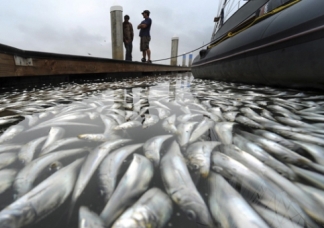 LOS ANGELES – Dolphins and sea lions that have died along the Southern California coast in recent weeks may be victims of a deadly neurotoxin produced by a seasonal algae bloom, experts have said.
LOS ANGELES – Dolphins and sea lions that have died along the Southern California coast in recent weeks may be victims of a deadly neurotoxin produced by a seasonal algae bloom, experts have said.
The same poison was found in samples from millions of fish that suffocated in a Redondo Beach harbor last month, and researchers hope to determine if it is present in samples from a similar but smaller fish die-off Monday in Ventura Harbor.
Experts don’t believe the fish died from the toxin but some marine mammals have become its victims.
In the past few days, three sea lions and three dolphins that beached themselves in Orange County died or were destroyed because they had incurable domoic acid poisoning, said Kirsten Sedlick, animal care supervisor for the Pacific Mammal Center in Laguna Beach.
On Tuesday, the center dispatched crews to rescue another four dolphins and a sea lion, she said. Tests will determine whether they also were victims of the neurotoxin.
“We just have all of our crews on high-alert” and extra volunteer teams are out, said Melissa Sciacca, the center’s director of development.
Domoic acid is produced naturally, but levels often soar in the spring with the blooming of a certain species of algae off the California coast. At least one bloom was spotted in the past few weeks off the Southern California coast.
Mussels and small fish eat the algae and concentrate the poison, then are eaten in turn by pelicans and sea mammals.
Since April 3, the National Oceanic and Atmospheric Administration has received reports of about 40 sea lions and 17 dolphins with domoic acid poisoning symptoms.
Most were off Los Angeles and Orange counties.
The outbreak was still relatively mild but it was too early to tell whether it might become more serious, said Joe Cordaro, an NOAA wildlife biologist.
“You never know how bad they’re going to be, and we still don’t know what the factors are that cause these major blooms,” he said. “We don’t know if it’s (storm) runoff, we don’t know if its high temperatures … there’s just so many factors.”
In 2002 and 2003, domoic acid poisoning was blamed for sickening or killing more than a thousand sea lions and 50 dolphins in Southern California.
Sick marine animals often beach themselves, Sedlick said.
“What we are seeing is all adult sea lions,” she added. “They are pregnant … they are engorging themselves on those fish that have ingested this (algae).”
“We’ve had … years when we’ve been inundated” with sick animals, Sedlick said.
Humans aren’t at risk unless they consume contaminated shellfish.
Because of elevated domoic acid levels, the California Department of Public Health put its annual quarantine on sport harvesting of wild mussels into effect on March 29 — a month earlier than usual. Commercially harvested mussels are not affected, the agency said.
The agency warns that eating tainted mussels can cause severe illness, coma and even death. The quarantine runs through Oct. 31.
The department declined to speculate on why the levels were high so early.
Domoic acid also was found in sardines taken from Redondo Beach on the Los Angeles County coast, where an estimated 2.5 million fish crowded into King Harbor, depleted the oxygen and suffocated last month.
What caused the fish to pack in to the harbor is unknown.
But the discovery of the toxin in those fish triggered a search for an algae bloom and a “significant” one was found offshore in the San Pedro Channel, said David Caron, a professor of biological science at the University of Southern California.
That bloom dropped off quickly, so marine mammal strandings a month later clearly mean there is another bloom although its location is unknown, he said.
Whether the fish that died Monday in Ventura Harbor, more than 60 miles northwest of Redondo Beach, contain domoic acid is unknown.
Caron said he had contacted the harbormaster to obtain samples of the fish for testing.
The Ventura County Star newspaper reported that an unusually large number of porpoises were in the harbor Monday feasting on the fish.
As with the Redondo Beach incident, the fish are believed to have used up the oxygen and suffocated. While the King Harbor cleanup required days of scooping out fish and hauling them off to a composter, the Ventura Harbor patrol filled barrels and dumped them at sea.


